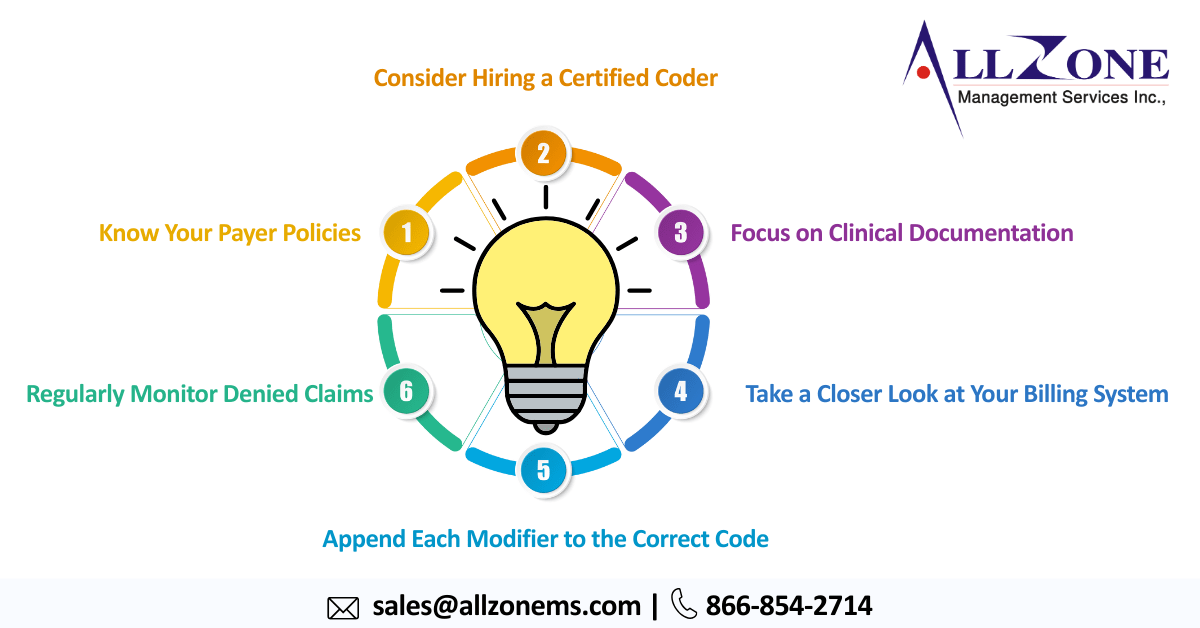In medical coding, CPT modifier are vital for accurate reimbursement of healthcare services. These special codes, attached to primary procedure codes, provide additional details about the complexity or extent of a service. However, using modifiers incorrectly can lead to claim denials and lost revenue.
This blog post shares six key tips to help you get reimbursed for the CPT modifiers you deserve. By following these guidelines, you can optimize your medical billing process and boost your practice’s financial health.
1: Know Your Payer Policies
Different insurance companies have varying policies regarding which modifiers they recognize and under what circumstances. Understanding these nuances is crucial.
-
- Obtain Payer Manuals: Most payers have online manuals or resources outlining their specific coding and modifier policies. Familiarize yourself with these resources for the payers your practice frequently deals with.
- Stay Updated: Payer policies can change periodically. Regularly reviewing these manuals ensures you are using the most current information.
2: Consider Hiring a Certified Coder
A certified coder has the expertise to navigate the complexities of medical coding and modifier application. They can:
-
- Review Charts and Assign Modifiers: Analyze patient charts and determine which modifiers are appropriate based on the service provided.
- Stay Up-to-Date on Coding Guidelines: Certified coders commit to continuing education, ensuring they stay current on the latest CPT coding and modifier guidelines.
3: Focus on Clinical Documentation
Modifiers are only effective if supported by thorough clinical documentation in the patient’s medical record.
-
- Detailed Notes: The physician’s notes should clearly document the rationale for using a particular modifier.
- Specificity Matters: Ensure the documentation reflects the specific details justifying the modifier. For instance, if using modifier -25 (significant, separately identifiable E/M service), the notes should outline the distinct history, exam, and medical decision-making for both services provided during the same encounter.
4: Take a Closer Look at Your Billing System
Your billing system plays a crucial role in ensuring accurate modifier application.
-
- Template Review: Evaluate any templates or billing automation tools you use. Do they encourage the use of modifiers when not warranted, or conversely, omit necessary modifiers?
- Reporting Features: Ensure your billing system allows for clear and accurate reporting of modifiers alongside the primary procedure codes.
5: Append Each Modifier to the Correct Code
Attaching modifiers to the wrong codes is a common mistake that can lead to claim denials.
-
- Understanding Modifier Placement: Certain modifiers apply to procedure codes, while others are meant for Evaluation and Management (E/M) codes. Familiarize yourself with the appropriate placement for each modifier.
- NCCI Edits and Payer Bundling Rules: National Correct Coding Initiative (NCCI) edits and specific payer bundling rules may dictate which modifiers can be used with specific procedure codes. Stay informed about these regulations.
6: Regularly Monitor Denied Claims
Denials can be a valuable learning tool. Regularly reviewing denied claims and the associated reasons can help identify areas for improvement in modifier usage and documentation.
-
- Analyze Denial Reasons: Pay close attention to the specific reasons for modifier-related denials. This can help identify patterns and areas for improvement.
- Educate Providers: Share insights from denial analysis with your healthcare providers. This can help them tailor their documentation to better support modifier use.
By following these six tips, you can ensure proper CPT modifier application, maximize reimbursement for your practice, and streamline your billing process. Accurate coding and complete documentation are key to getting paid for the valuable services your practice provides.

